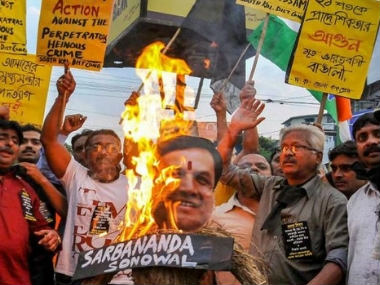Security forces have gone into an overdrive to nab the United Liberation Front of Assam (ULFA) militants who allegedly carried out the killings in Assam’s Tinsukia more than a week ago. Unconfirmed reports said that the killers might have escaped to the neighbouring Myanmar and it delayed the arrest of the accused. A combined team of the police from Assam and Arunachal Pradesh, army as well as the CoBRA team from the CRPF has been pressed into action in the Tengapani Reserve Forest a day after the massacre was orchestrated at Dholla on 1 November in which five people were killed. Tinsukia superintendent of police Mughdha Jyoti Mahanta has confirmed the development and said that the operation was still on to apprehend the militants behind the killings. [caption id=“attachment_5538661” align=“alignleft” width=“380”] File image of a protest against Tinsukia massacre. News 18[/caption] The reserve forest known for its dense cover straddles Tinsukia and Namsai in the neighbouring Arunachal Pradesh. The rebels supposedly escaped through the Bogoribari-Mikirgaon route to reach Tengapani where they were reportedly received by a small squad. Subsequently, they headed to another spot deep inside the forest where they were holed up for at least two more days. Inputs received from an intelligence agency suggested that Gyan Asom, Bubul Moran, Dimbeswar Moran, Jasinta Moran and Justin Doley were in the group that executed the operation. An official said that most of them hailed from Tinsukia and were recruited by the ULFA about two years ago. He explained that the rebels wore army fatigue and spoke Hindi to confuse the residents of Bisonimukh village where the five victims were shot. “This was a clever tactic to buy time as people would not suspect them to be militants. In such circumstances, a few minutes could make a lot of difference and help the rebels reach a safe location. It is also possible that they came through the same route to reach the village which was also used to escape,” he said. Security agencies had received inputs about the ULFA’s plans to carry out a strike weeks ahead of the incident on 1 November. So far, only one person identified as Diklai Gogoi has been arrested on the suspicion that he might have a role in the massacre. ULFA’s long association with Tengapani The proscribed ULFA has an old association with Tengapani Reserve Forest that goes back to the late 1980s when training camps of the banned outfit across Assam were established. Two of the biggest camps were at Lakhipathar which housed the general headquarters and its training centre at Saraipung. Both were not very far from the reserve forest. Most of these camps were dismantled during the Operation Bajrang which was launched on 28 November, 1990. The top leaders and functionaries of the ULFA parted ways but they were on the run for several months as the army continued with its operation without the assistance of the police. The ULFA cadres managed to assemble and erect a camp at Tengapani Reserve Forest around April where its chief Paresh Baruah and publicity secretary Sunil Nath were reportedly present. This camp also came to an end three months later after it was raided by the CRPF. In the next two decades, several routes were established through Tengapani that led straight to the Indo-Myanmar border through Changlang. It became the most prolific when the dreaded 28 Battalion was created in the late 1990s which carried out several operations in Tinsukia and Diburgarh. A camp which was established around 2005 survived for two years before it was abandoned. “Rebels might have escaped to Myanmar” The operation’s failure to nab the accused so far has forced a section of army and police officials to believe that the militants might have crossed the border and reached Myanmar. However, the exercise is likely to continue for a few more days to prevent the possibility of more rebels sneaking into the jungles. An official who is part of the operation said,“They (militants) are more acquainted with the jungles here than us. The group that carried out the killings is likely to have crossed over to the neighbouring Changlang district three or four days after the killings.” Changlang is still a stronghold of the Khaplang faction of the National Socialist Council of Nagaland (NSCN-K) which is an ally of the ULFA. The network and support base of the Naga outfit has always been made use of by the ULFA for securing safe hideouts and for escaping to Myanmar. Meanwhile, a meeting scheduled at the army’s 2 Mountain Division at Dinjan in Tinsukia on Tuesday is likely to be attended by the top brass of the police and army to take stock of the situation. Joint secretary Satyendra Garg who is in charge of the northeast at the ministry of home affairs is also expected to be present at the meeting. An official admitted the possibility of greater deployment of security forces in the “vulnerable areas” of upper (eastern) Assam within the next few weeks. Bhattacharyya is a senior journalist in Guwahati and author of Rendezvous With Rebels: Journey to Meet India’s Most Wanted Men & Lens and the Guerrilla: Insurgency in India’s Northeast
A combined team of the police from Assam and Arunachal Pradesh, army as well as the CoBRA team from the CRPF has been pressed into action in the Tengapani Reserve Forest a day after the massacre was orchestrated at Dholla.
Advertisement
End of Article


)

)
)
)
)
)
)
)
)



